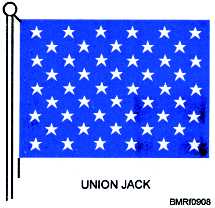pennant (called PREP) is hoisted. Ceremonies for
colors begin when PREP is hauled to the dip (the
halfway point).
Navy ships not under way also hoist and lower the
union jack on the jackstaff, at the ship’s bow, and at
morning and evening colors. The union jack is also
flown from a yardarm to denote that a general
courts-martial or court of inquiry is in session. The
union jack is the rectangular blue part of the United
States flag containing the stars (fig. 9-8).
If a band is available for color ceremonies,
“Attention” is sounded, followed by the band playing
the national anthem. At morning colors, hoisting the
ensign begins when the music starts. It is hoisted
smartly to the top of the flagstaff. At evening colors,
lowering of the ensign also starts at the beginning of the
music. Hoisting and lowering of the ensign are
completed at the last note of the music. The national flag
is always hoisted smartly and lowered ceremoniously.
“Carry on” is sounded at the completion of the music.
If a band is not available for colors, “To the Colors”
is played on the bugle at morning colors, and “Retreat”
is played at evening colors. For ships without a band or a
bugler, “Attention” and “Carry on” are signals for
beginning and terminating the hand salute.
Sometimes the music for colors from another U.S.
ship can be overheard aboard your ship. When this
happens, and no band or bugler is aboard your ship, the
command to “Carry on” should not be given until the
music being overheard is completed.
After morning colors, if foreign warships are
present, the national anthem of each country
represented is also played. If your ship is visiting a
foreign country, the national anthem of that country is
played immediately following morning colors,
followed by the national anthems of any other foreign
nations represented. You should show the same respect
for national anthems of foreign countries as you do for
our own.
On Sundays, authorized holidays, and other days
proclaimed by the President, the largest national ensign
in the ship’s or station’s allowance is flown. This ensign
is referred to as holiday colors. When the holiday colors
are flown on a Navy ship not under way, the union jack
flown is the same size as the blue field in the holiday
colors.
Ships that are under way do not hold morning or
evening colors because the ensign usually is flown day
and night. Just as the ship gets under way, the ensign is
shifted from its in-port position on the stern to its at-sea
position at the mainmast. This is called shifting the
colors.
HALF-MASTING THE ENSIGN
National flags flown at half-mast (or half-staff
ashore) are an internationally recognized symbol of
mourning. The United States honors its war dead on
Memorial Day by half-masting the flag from 0800 until
the last gun of a 21-minute-gun salute that begins at
noon (until 1220 if no gun salute is rendered).
Normally, the flag is half-masted on receiving
information of the death of one of the officials or
officers listed in U.S. Navy Regulations. Notification
may be received through news media reports or by an
official message.
In half-masting an ensign already flying at the peak
or truck aboard ships under way, lower it ceremoniously
to half-mast. If the ensign is not flying, hoist it smartly
to the peak or truck before lowering it to half-mast. In
lowering a half-masted ensign, raise it first to the peak
or truck, then lower it ceremoniously.
When the national anthem, “To the Colors,” or
“Retreat” is played at morning or evening colors aboard
ships not under way, all hands should hold the salute
during the raising or lowering of the flag. In
half-masting during morning colors, “Carry on” should
9-12
Student Notes:
Figure 9-8.—Union Jack.


